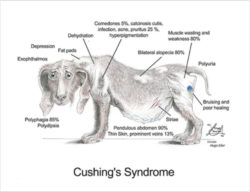Cushing’s disease (or hyperadrenocorticism) is one of the most common endocrine disorders that affects dogs. The endocrine system is the collective system of glands that produce and secrete hormones in the body, one of which is the hormone cortisol. At normal levels, cortisol performs many useful functions, including stress responses and modulating the immune system. In excess though, cortisol can have harmful effects on the body. Cushing’s disease refers to a condition in which there is excessive cortisol levels in the body.
Cushing’s disease can develop either when a dogs body overproduces cortisol, or when a dog is given corticosteroid medications (ie prednisolone) at high doses or over a long period of time.
Symptoms:
Hyperadrenocorticism generally affects middle-aged to older animals.
Common symptoms associated with the disease:
- Increased thirst and urination
- Increased hunger
- Panting
- Pot-bellied appearance to abdomen
- Obesity
- Recurrent infections of skin, ears, urinary tract, etc.
- Hair loss
- Lack of energy
- Muscle weakness
- Thin skin
- Appearance of blackheads or white scaly patches on the skin.
Not all these symptoms are apparent in every patient.
Risk Breeds:
All dogs can get Cushing’s disease, but the following breeds have an increased risk:
- Poodles
- Dachshund
- Small terriers (yorkshire, Jack Russell, staffordshire)
Cause of Cushing’s Disease in Dogs:
Pituitary tumour:
Pituitary tumours are the most common cause of cushing’s disease in dogs, accounting for >80% of dogs with the condition. The majority of these pituitary tumours are caused by a benign tumour, with malignant tumours being much less common. This form of the disease is referred to as pituitary dependent hyperadrenocorticism (PDH).
Adrenal gland tumours:
Adrenal gland tumours account for approx 15-20% of naturally occuring Cushing’s disease in dogs. These tumours have a 50:50 chance of being benign or malignant.
Iatrogenic:
Excessive administration of corticosteroid medication can also cause cushing’s disease in dogs. We commonly use these drugs to treat allergies, immune disorders and some types of cancers, they are also an anti-inflammatory medication. When used at higher doses, or for extended periods of time dogs can manifest hyperadrenocorticism.
Diagnosis:
The first step in diagnosing Cushing’s disease is performing a physical examination in which we will take a comprehensive history and a complete physical exam. From here we will usually take bloods and a urine sample for analysis for a general health check.
If based on this initial assessment we are suspicious that Cushing’s disease is a likely cause of your dog’s symptoms, we will then run further tests that are necessary to definitively diagnose the condition.
Usually, our first diagnostic test of choice is an ACTH stimulation test, as this is a simple and quick test to perform. It measures how well the adrenal glands work in response to a hormone called ACTH that usually prompts them to make cortisol. It involves taking two blood samples an hour apart – resting cortisol and cortisol post ACTH stimulation.
Although this is a good screening test for Cushing’s disease there are a few cases that will have false negative results (everything points to the disease but results not consistent) and in these cases, when we are still suspicious that the dog may have Cushing’s disease, we may run another blood test called a low- dose dexamethasone suppression test.
Low dose dexamethasone suppression test: A blood sample is taken to measure a dog’s baseline cortisol level and then a small amount of dexamethasone is administered by injection. Blood cortisol levels are measured four and eight hours after the dexamethasone is given. In a normal dog, the dexamethasone injection inhibits secretion of a hormone that stimulates cortisol secretion, which leads to a decrease in circulating cortisol levels. In a dog with Cushing’s disease, cortisol is not suppressed.
Unfortunately, no one diagnostic test is definitive for Cushing’s disease in all cases. We may need to also run other tests and/or perform an abdominal ultrasound to determine whether or not a dog has Cushing’s.
Treatment:
Usually by the time Cushing’s disease has been diagnosed your dog will already have quite obvious clinically disease and thus treatment is usually warranted at the time of diagnosis, due the potential deleterious effects of the disease on your pets health.
Once the decision has been made to begin treatment a medication will be prescribed named trilostane. Close monitoring of the animal is important as this medication does not come without potential side effects. Repeated ACTH stimulation tests are then required at regular intervals until we are happy with the results and the animal is showing signs of clinical improvement. Once we have reached this point we will usually perform follow up ACTH stimulation tests every 3-6 months for monitoring purposes and adjustments in dosing will be made as necessary.
If the disease has developed due to administration of corticosteroid medication, the dog will be slowly weaned off the medication under supervision and signs should resolve.
Living with a Dog with Cushing’s Disease:
Once your dog has begun treatment with medication for cushings disease you need to be prepared to continue medication for the life of your pet. You will need to be observant for any adverse reactions to these medications. Typical signs of an adverse reaction are – lack of energy, weakness, lack of appetite, vomiting, diarrhoea, and sometimes difficulty walking. If any of these side effects should occur you should discontinue the medication and contact us immediately. We may also prescribe some corticosteroid medication to be used in these circumstances, or during periods of stress in which your pet may need additional cortisol to respond to the situation.






